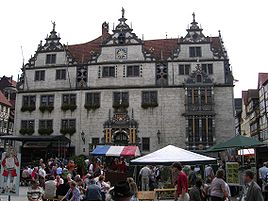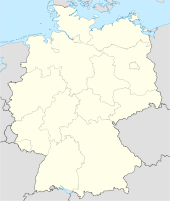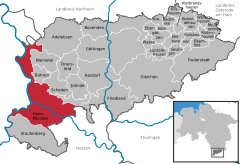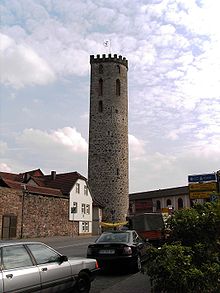- Hann. Münden
-
For the nearby town, site of a battle in 1757, see Minden. For the small town in the United States, see Munden, Kansas. For the park in Virginia Beach, VA, see Munden Point.
Hann. Münden Town hall 
Coordinates 51°25′N 9°39′E / 51.41667°N 9.65°ECoordinates: 51°25′N 9°39′E / 51.41667°N 9.65°E Administration Country Germany State Lower Saxony District Göttingen Town subdivisions 11 Mayor Klaus Burhenne (CDU) Basic statistics Area 121.11 km2 (46.76 sq mi) Elevation 123 m (404 ft) Population 24,525 (31 December 2010)[1] - Density 203 /km2 (524 /sq mi) Other information Time zone CET/CEST (UTC+1/+2) Licence plate GÖ Postal code 34346 Area code 05541 Website www.hann.muenden.de Hann. Münden (short for Hannoversch Münden) is the German official name of a town in Lower Saxony, Germany. The city is located in the district of Göttingen at the confluence of the Fulda and Werra rivers, which join to form the river Weser. It has 28,000 inhabitants. It is famous for its old houses, some of them more than 600 years old.
The place is first mentioned in the deed of donation of Gimundi to the abbey of Fulda (802). City rights were probably granted during the latter half of the 12th century. The name of the town was originally Münden. The official name was changed to Hannoversch Münden (from the former affiliation with the kingdom of Hanover) in order to distinguish Münden from Minden (which is similarly pronounced). Later, to avoid confusion with Hanover, the city's name was abbreviated to Hann. Münden. Inhabitants still generally refer to their own town as Münden.
Contents
Main sights
The large Lutheran church of St Blasius (14th-15th centuries), in Gothic style, contains the sarcophagus of Duke Eric I of Brunswick-Calenberg (d. 1540).
Other sights include:
- Forstbotanischer Garten in Hannoversch Münden, an arboretum
- Remains of the medieval 12th century city walls (renewed in the 15th century)
- Tillyschanze, an observation tower built from 1881 to 1885 by citizens of the town to remember the siege of the town by Count Tilly in 1626.
- Welfenschloss, originally built by duke Eric I in Gothic style in 1501, as both a residence and administrative center. After its destruction by a fire in 1560, duke Eric II had it rebuilt in Weser Renaissance style. The southern wing was again destroyed by a fire in 1849, but not rebuilt.
- Old Werrabrücke, one of the oldest stone bridges in the country
- Renaissance Town Hall, built in the 14th century (now the central Gothic hall remains) and renewed in the façade between 1603 and 1618.
Twin towns
 Suresnes, France, since 1959
Suresnes, France, since 1959 Hackney, United Kingdom, since 1973
Hackney, United Kingdom, since 1973 Holon, Israel, since 1988
Holon, Israel, since 1988 Chełmno, Poland, since 1992
Chełmno, Poland, since 1992
See also
- Hedemünden
- Metropolitan region Hannover-Braunschweig-Göttingen-Wolfsburg
References
- ^ "Bevölkerungsfortschreibung" (in German). Landesbetrieb für Statistik und Kommunikationstechnologie Niedersachsen. 31 December 2009. http://www1.nls.niedersachsen.de/statistik/html/parametereingabe.asp?DT=K1000014&CM=Bev%F6lkerungsfortschreibung.
External links
- http://www.hann.muenden.de/ - Official city homepage
- http://www.hann.muenden-tourismus.de/ - Official tourist office of Hann. Münden
 Chisholm, Hugh, ed (1911). "Münden". Encyclopædia Britannica (11th ed.). Cambridge University Press.
Chisholm, Hugh, ed (1911). "Münden". Encyclopædia Britannica (11th ed.). Cambridge University Press.
Adelebsen | Bilshausen | Bodensee | Bovenden | Bühren | Dransfeld | Duderstadt | Ebergötzen | Friedland | Gieboldehausen | Gleichen | Göttingen | Hann. Münden | Jühnde | Krebeck | Landolfshausen | Niemetal | Obernfeld | Rhumspringe | Rollshausen | Rosdorf | Rüdershausen | Scheden | Seeburg | Seulingen | Staufenberg | Waake | Wollbrandshausen | WollershausenCategories:- Towns in Lower Saxony
Wikimedia Foundation. 2010.





